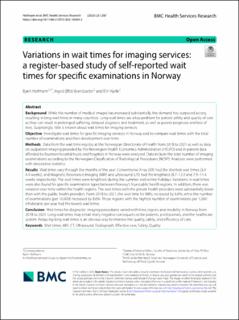| dc.contributor.author | Hofmann, Bjørn Morten | |
| dc.contributor.author | Brandsæter, Ingrid Øfsti | |
| dc.contributor.author | Kjelle, Elin | |
| dc.date.accessioned | 2024-01-24T09:02:39Z | |
| dc.date.available | 2024-01-24T09:02:39Z | |
| dc.date.created | 2023-12-12T09:58:56Z | |
| dc.date.issued | 2023 | |
| dc.identifier.citation | BMC Health Services Research. 2023, 23 (1), . | en_US |
| dc.identifier.issn | 1472-6963 | |
| dc.identifier.uri | https://hdl.handle.net/11250/3113491 | |
| dc.description.abstract | Background
While the number of medical images has increased substantially, the demand has outpaced access, resulting in long wait times in many countries. Long wait times are a key problem for patient safety and quality of care as they can result in prolonged suffering, delayed diagnosis and treatment, as well as poorer prognosis and loss of lives. Surprisingly, little is known about wait times for imaging services.
Objective
Investigate wait times for specific imaging services in Norway and to compare wait times with the total number of examinations and their development over time.
Methods
Data from the wait time registry at the Norwegian Directorate of Health from 2018 to 2021 as well as data on outpatient imaging provided by the Norwegian Health Economics Administration (HELFO) and in-patient data afforded by fourteen hospital trusts and hospitals in Norway were analysed. Data include the total number of imaging examinations according to the Norwegian Classification of Radiological Procedures (NCRP). Analyses were performed with descriptive statistics.
Results
Wait times vary through the months of the year. Conventional X-ray (XR) had the shortest wait times (3.0-4.4 weeks), and Magnetic Resonance Imaging (MRI) and ultrasound (US) had the lengthiest (8.7–12.0 and 7.9–11.4 weeks respectively). The wait times were lengthiest during the summer and winter holidays. Variations in wait times were also found for specific examination types between Norway’s four public health regions. In addition, there was variation over time within the health regions. The wait times with the private health providers were substantially lower than with the public health providers. From 2018 to 2021, the wait time for MRIs increased by 6.6%, while the number of examinations (per 10,000) increased by 8.6%. Those regions with the highest number of examinations per 1,000 inhabitants per year had the lowest wait times.
Conclusion
Wait times for diagnostic imaging procedures varied with time, region, and modality in Norway from 2018 to 2021. Long wait times may entail many negative consequences for patients, professionals, and the healthcare system. Reducing long wait times is an obvious way to improve the quality, safety, and efficiency of care. | en_US |
| dc.language.iso | eng | en_US |
| dc.publisher | BioMed Central Ltd. | en_US |
| dc.rights | Navngivelse 4.0 Internasjonal | * |
| dc.rights.uri | http://creativecommons.org/licenses/by/4.0/deed.no | * |
| dc.title | Variations in wait times for imaging services: a register-based study of self-reported wait times for specific examinations in Norway | en_US |
| dc.title.alternative | Variations in wait times for imaging services: a register-based study of self-reported wait times for specific examinations in Norway | en_US |
| dc.type | Peer reviewed | en_US |
| dc.type | Journal article | en_US |
| dc.description.version | publishedVersion | en_US |
| dc.source.volume | 23 | en_US |
| dc.source.journal | BMC Health Services Research | en_US |
| dc.source.issue | 1 | en_US |
| dc.identifier.doi | 10.1186/s12913-023-10284-2 | |
| dc.identifier.cristin | 2212165 | |
| cristin.ispublished | true | |
| cristin.fulltext | original | |
| cristin.qualitycode | 2 | |

